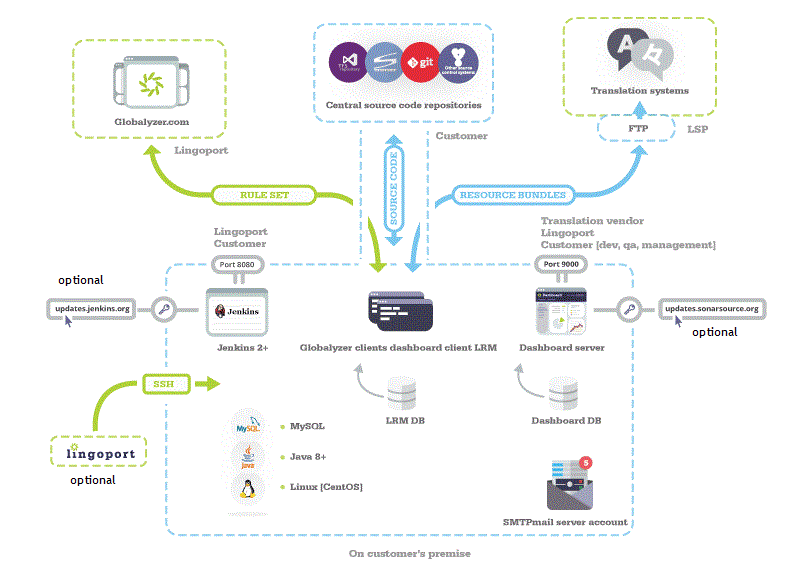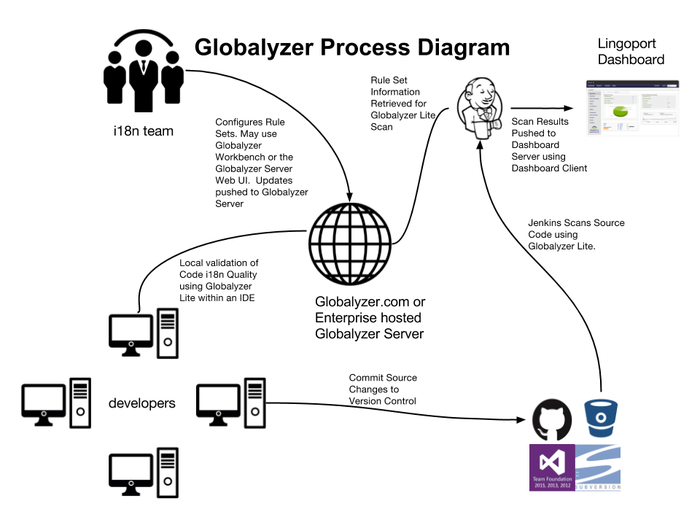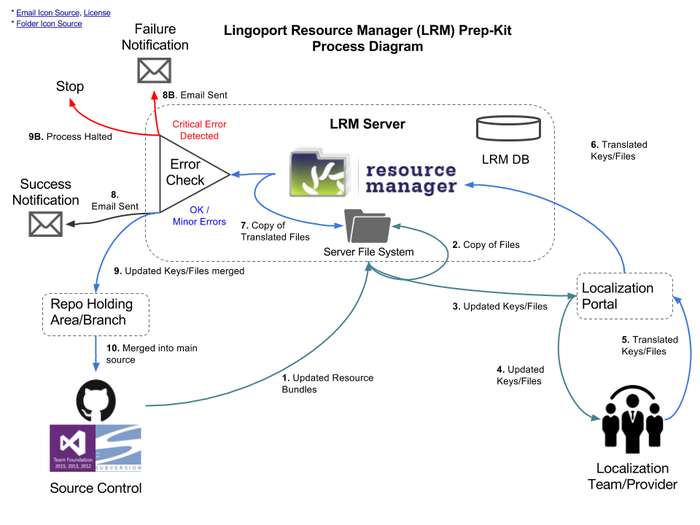Difference between revisions of "Deployment Scenarios"
(→Typical Deployment and Ports) |
(→A typical workflow=) |
||
| Line 27: | Line 27: | ||
* updates.sonarsource.org: The Lingoport Dashboard uses SonarQube as its framework and needs the ability to download updates and fixes. |
* updates.sonarsource.org: The Lingoport Dashboard uses SonarQube as its framework and needs the ability to download updates and fixes. |
||
| − | =A typical workflow== |
+ | ==A typical workflow== |
# Code is committed to a central source code repository (Git, Subversion, etc) by developers |
# Code is committed to a central source code repository (Git, Subversion, etc) by developers |
||
# Jenkins tools pull the source code from the code repository and scan using Rule Sets stored on the Globalyzer Server or analyze the resource files |
# Jenkins tools pull the source code from the code repository and scan using Rule Sets stored on the Globalyzer Server or analyze the resource files |
||
Revision as of 15:52, 26 May 2017
The Lingoport Suite is composed of Globalyzer, LRM (Resource Manager) and the Lingoport Dashboard. A number of other products are used with the Suite. You may need some of the components for a set of users and other components for Continuous Globalization.
Contents
Typical Deployment and Ports
Setting up the Lingoport Continuous Globalization System at a customer site can be done in many ways, as shown in the different deployment scenarios. The following is meant to show some of the flow and the necessary access to the system.
- The Customer's systems are shown in Light Blue; CentOS for the main system where Jenkins and Dashboard reside.
- Access from outside the Customer's system are shown in Light Green.
The large blue box is the Lingoport Server. It is a Linux (CentOS or RedHat) operating system that has the following installed:
- Jenkins (running on port 8080)
- Java
- MySQL
- Globalyzer clients
- Lingoport Dashboard Server (running on port 9000) and Database
- Lingoport Dashboard Client
- LRM Server and Database
- SMTP mail server account
The Globalzyer Server is either a hosted Lingoport server or another onsite server.
The optional items shown:
- updates.jenkins.org: The Lingoport Server should be able to download updates to Jenkins.
- SSH: Allowing Lingoport to log in to the customer Lingoport Server improves our ability to support the products.
- updates.sonarsource.org: The Lingoport Dashboard uses SonarQube as its framework and needs the ability to download updates and fixes.
A typical workflow
- Code is committed to a central source code repository (Git, Subversion, etc) by developers
- Jenkins tools pull the source code from the code repository and scan using Rule Sets stored on the Globalyzer Server or analyze the resource files
- Jenkins tools determine if the resource files need to be sent to, or imported from, the translation vendor. This may be done via an FTP connection.
- Emails are sent to designated recipients about the status of the translation upload or import.
- Lingoport Dashboard updates the status using the results of the Globalyzer scans and LRM resource status.
External Access and Ports
- Ability to install/update programs via 'yum'.
- Jenkins is accessed via port 8080 within Customer's firewall for Linux system
- Lingoport Dashboard is accessed via port 9000 within Customer's firewall for Linux system
- The Translation Vendor may be accessed by different means, for instance port 21 for FTP or port 22 for SFTP.
- Download does not have to be directly to the target machine. It can be downloaded by another machine and then transferred.
- Access for the Lingoport (or internal) installation team can be done in many ways, such as SSH for Telnet or Putty.
- Linux system must be able to access https://globalyzer.com.
Optional Access
You may want to update either Jenkins or the underlying Dashboard platform to the latest version. If so, you may want to update the continuous globalization system directly or to download the files on one system and copy them over to the continuous globalization system. The URL for updates are:
- https://updates.jenkins-ci.org
- https://update.sonarsource.org
- https://repo.mysql.com
- http://pkg.jenkins-ci.org/redhat-stable/jenkins.repo
- https://jenkins-ci.org/redhat/jenkins-ci.org.key
Furthermore, email notification emails require an SMTP account. The SMTP server access may be internal to your Company or external depending on your email services (e.g. smtp.gmail.com for Google).
Installation Components
Globalyzer
Scan code and detect internationalization (i18n) issues
Globalyzer Server
Stores (regex) scanning rules.
- Stores regex pattern based 'rule sets' used to detect i18n issues and filter out false positives and Globalyzer accounts.
- Does not store any code or customer information.
Globalyzer Clients
Displays i18n issues.
- Connects to server and logs in. Downloads rule set from server. Uses rule set to scan code (no code is sent to the server!). May push rule set changes.
- Run on developer machines
- Run on Linux system (light-blue box at bottom of graphic) - results displayed on Lingoport Dashboard (see data flow)
Resource Manager
Manages translation resource files.
- Detects issues in resource files (duplicate or missing keys, parameter mismatch in text for different languages, etc.)
- Detects changes to Chinese resource files. Then sends relevant changes out to the translation vendor for translation into other languages.
- Automatically retrieves translations from translations vendors and checks those changes into source control
- Run on Linux system (light-blue box at bottom of graphic)
Lingoport Dashboard
Displays internationalization and localization status.
- Displays overview of Globalyzer and Resource Manager status
- Users may view Globalyzer/Resource Manager issues in context within source code
- Run on linux system (light-blue box at bottom of graphic)
Jenkins (not a Lingoport program)
Used to automate running of Globalyzer Client, Resource Manager and updating of the Lingoport Dashboard
- Run on Linux system (light-blue box at bottom of graphic)
Data Flow
Lingoport Access
It's most convenient if Lingoport can have SSH access to the Linux system where Lingoport suite is configured. Otherwise, a Lingoport employee can guide an customer's employee through the setup using a videoconferencing program such as WebEx or GoToMeeting.
Globalyzer Process
Rule sets (regex data) are transferred between Globalyzer Server and Globalyzer Clients; This requires username/password based login.
- Server at Globalyzer.com
- Clients are run on developer machines.
- Clients are run on Lingoport Suite Linux system.
- Clients generate XML reports that will be read by the Lingoport Dashboard.
Resource Manager Process
Sends to-be-translated resource files updates to translation vendor, typically over SFTP. Resource file updates received from translation vendor, also typically over SFTP. Updates are checked for consistency (various in-depth checks), and then committed to source control -- if the checks pass.
- Emails are sent to a list of email contacts defined in a configuration file.
- Notifications for sent / received resource files
- Error notifications
- Translation status weekly email
- Stores data in MySQL database
- Run on Linux system (light-blue box at bottom of graphic)
- Generates XML reports that will be read by the Lingoport Dashboard.
Lingoport Dashboard
Internal within customer network. XML Reports generated by Globalyzer and Resource Manager are uploaded via the Dashboard Client to the Dashboard Server. Dashboard Client sends code information to Dashboard Server.
- Resource Manager and Globalyzer are run on a server internal to Customer's network. Each generates an XML report.
- Dashboard Client reads both source code and these XML reports.
- Dashboard Client processes this data, and sends it to the Dashboard Server.
- Data sent over HTTP/HTTPS.
- Most often, the Dashboard Client and Dashboard Server are hosted on the same machine (light-blue box at bottom of graphic), so network communication is internal to this machine.
- Requires a either a username/password or a user token, which will be stored in configuration files.
- Stores data in MySQL database.
- Dashboard Server is a web application, hosted on port 9000 by default.
Jenkins (not a Lingoport program)
Used to automate running of Globalyzer Client, Resource Manager and updating of the Lingoport Dashboard
- Various security options available, username/password is most common. LDAP is another option.
- Run on Linux system (light-blue box at bottom of graphic)
- Web application, hosted on port 8080 by default.
Additional Deployments Scenarios
In the Additional Deployments section, we illustrate some possible deployments:
- Team Members
- i18n specialists
- Developers
- Other Continuous Globalization Deployments


